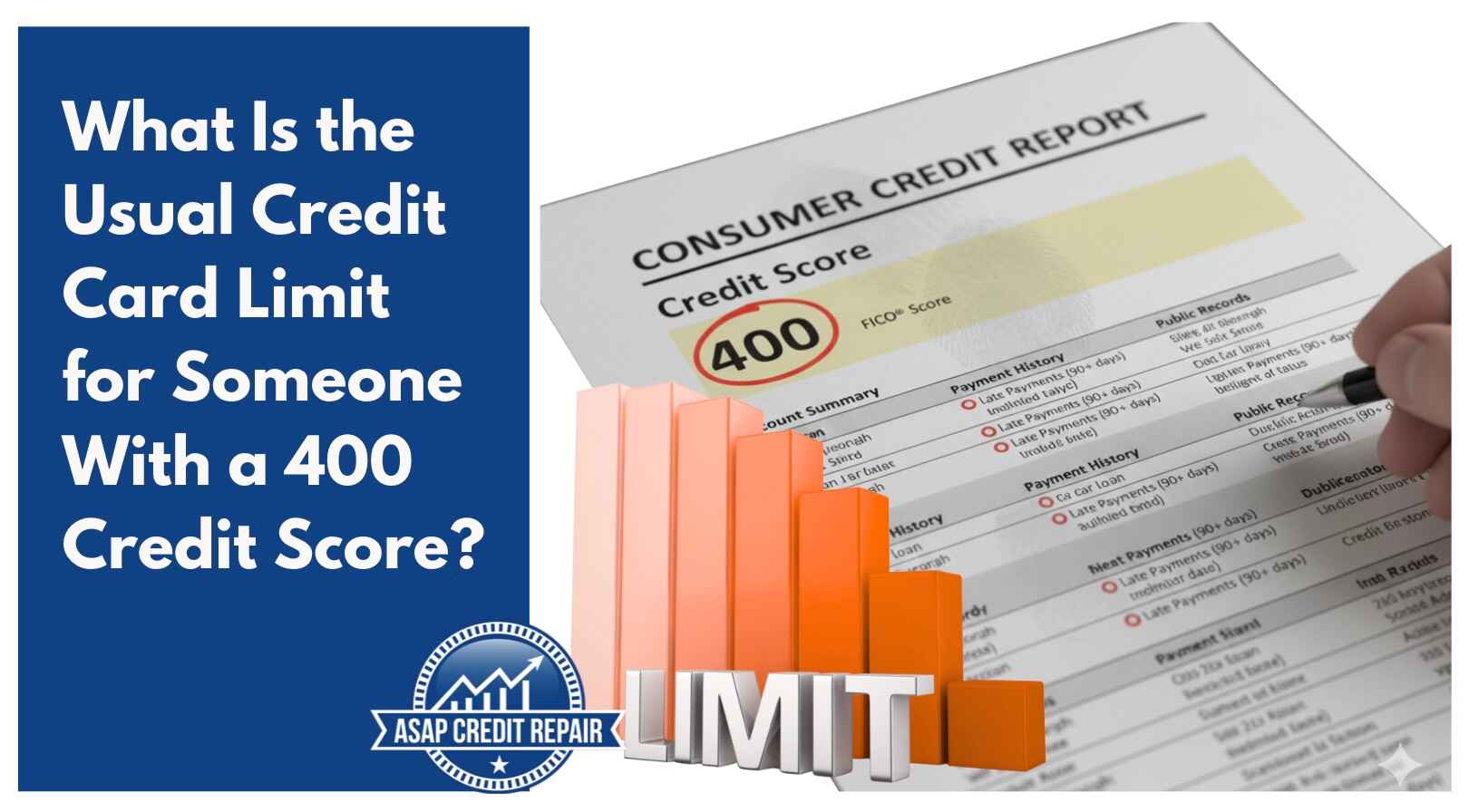Having a 400 credit score ranks you in the bottom 16% of all Americans.
In real life, that means almost every door in the financial world is slammed shut before you even knock. Credit card companies see you as too risky, lenders won’t touch your application, and even everyday things, like getting approved for an apartment lease, financing a car, or setting up utilities—suddenly come with huge deposits or outright denials. It’s not just a number on a report; it’s a barrier that affects your daily life and your ability to move forward.
With the average credit score sitting at 715 as of 2024, having a 400 score means you're dealing with some serious credit challenges. And this affects real people every single day.
If your credit score has dropped into the 300s or 400s, you already know how tough it is to get approved for anything. Credit cards? Almost always denied. Limits? Practically useless.
The reason I created this content is to remind you that having a 400 score doesn’t mean you’re done for. You can live a better life. The trick is knowing where to look and setting the right expectations.
Why a 400 Credit Score Kills Your Approval Chances
A 400 credit score is what the credit industry politely calls "very poor credit." What they really mean is that lenders see you as a massive risk who probably won't pay them back. Fair or not, that's the reality you're dealing with.
At this credit level, you're looking at some harsh truths. Most mainstream credit cards, the ones with decent rewards, reasonable interest rates, and useful credit limits, won't even consider your application. The rejection rate for unsecured credit cards with scores below 450 is around 85-90%.
The few lenders willing to work with 400 credit scores are betting against you. They're charging sky-high interest rates and fees because they expect a lot of borrowers to default.
It's not personal; it's just math from their perspective.
See below the credit score ranges and typical approval rates, showing the dramatic drop in approval chances below 500:
Most people think credit card companies only care about your score, but that’s not the full picture. Lenders also look at your income, how much debt you’re already carrying, and your recent credit habits. In other words, not all 400 scores look the same. Someone with steady income and a few positive changes on their report is in a very different spot than someone with no income and a pile of fresh charge-offs.
Your Credit Card Options at 400 Credit Score
With a 400 credit score, you're not shopping at the credit card mall, you're shopping at the credit card thrift store.
Your options are limited, but they exist.
Secured Credit Cards: Your Best Starting Point
Secured cards are going to be your main option, and honestly, they're not terrible if you understand what you're getting. Most secured credit cards require a deposit of $200 to $300, and your credit limit is usually equal to your deposit.
So if you can scrape together $300 for a deposit, you get a $300 credit limit. Put down $500, get a $500 limit. Some cards allow deposits as high as $5,000, but let's be realistic. If you had $5,000 lying around, you probably wouldn't have a 400 credit score.
The upside of secured cards is that they're designed for people with terrible credit. Your approval odds are much higher, and many secured cards report to all three credit bureaus, helping you rebuild your score over time.
Store Cards: Limited but Possible
Some store credit cards have lower approval standards than general-purpose cards. Think Target, Walmart, or gas station cards. These typically offer credit limits between $150-500 for people with very poor credit.
The catch? You can usually only use them at that specific store or chain. The interest rates are usually terrible — often 25-30% APR. But if you need to establish some credit history and you shop regularly at these stores anyway, they can work.
Subprime Unsecured Cards: Proceed with Caution
Some unsecured cards, like the Petal® 1 Visa®, may not require a deposit and can help rebuild credit. These subprime unsecured cards typically offer credit limits between $200-500 for people with 400 credit scores.
But read the fine print carefully. These cards often have massive fees, annual fees, monthly maintenance fees, program fees, you name it. Some cards charge so many fees that your available credit gets eaten up before you even use the card.
What Affects Your Credit Limit
Credit limits aren't just random numbers that lenders pull out of thin air. They're calculated based on specific factors, and understanding these factors helps you maximize whatever limit you can get.
Your Income Matters More Than You Think
Even with a 400 credit score, having decent income helps. Credit card companies want to know you have money coming in to make payments. If you're making $50,000 a year with a 400 credit score, you'll likely get higher limits than someone making $25,000 with the same score.
Be honest about your income on applications, but don't forget to include all sources. This includes but not limited to, your main job, side hustles, alimony, social security, whatever.
Every dollar counts when lenders are evaluating your ability to pay.
Existing Debt Kills Your Chances
If you already owe money on other credit cards, loans, or accounts, new lenders get nervous about giving you more credit to potentially mess up with. High debt-to-income ratios are red flags, especially when combined with poor credit scores.
Before applying for new cards, pay down whatever debt you can. Even reducing your total debt by a few hundred dollars can help your approval odds and potential credit limits.
Recent Credit Behavior
Lenders look at what you've done lately, not just your overall credit score. Recent missed payments, new charge-offs, or bankruptcies make approval harder. But recent positive changes, like paying accounts current or settling old debts , can help.
If you've been working on cleaning up your credit, wait until those positive changes show up on your credit report before applying for new cards.
How to Grow Your Credit Limit Over Time
Getting approved for a card with a tiny credit limit isn't the end of the story, it's the beginning. Most people with 400 credit scores can work their way up to decent credit limits within 12-24 months if they play their cards right.
Use Your Card, But Don't Max It Out
Aim to use less than 30% of your available credit limit to avoid hurting your credit score. On a $300 credit limit, that means keeping your balance below $90. Yes, that's not much room to work with, but it's temporary.
Making small purchases and paying them off quickly shows lenders you can handle credit responsibly. Even buying gas or groceries and paying it off immediately helps establish positive payment history.
Pay On Time, Every Time
This one's obvious but worth repeating: never miss a payment. Set up automatic payments if you have to, but don't give lenders any excuse to think you can't handle credit. One late payment can set back your credit rebuilding efforts for months.
Request Credit Limit Increases
After 6-12 months of perfect payment history, ask for a credit limit increase. Many secured card issuers will increase your limit without requiring additional deposits once you've proven you can handle credit responsibly.
Some cards like Capital One may offer credit line increases based on payment history and creditworthiness with no additional deposit needed. Start with small increase requests, asking to go from $300 to $500 is more realistic than jumping to $2,000.
Transition to Better Cards
The goal isn't to keep a secured card forever. After 12-18 months of responsible use, you should be able to qualify for better unsecured cards with higher limits and fewer fees. Some secured card issuers will even convert your secured card to an unsecured card and return your deposit.
Below is an illustrative timeline showing typical credit limit growth over 24 months for responsible secured card users starting at 400 credit score:
Alternatives When Credit Cards Won't Work
Sometimes even secured credit cards won't approve people with 400 credit scores, especially if there are recent bankruptcies or current legal issues. Don't panic, you have other ways to start rebuilding credit.
Credit Builder Loans
Credit builder loans work backwards from regular loans. Instead of getting money upfront, you make monthly payments that get reported to credit bureaus. After you've made all the payments, you get the money back.
These loans typically range from $300-1,000 and have terms of 6-24 months. The monthly payments are usually small — $25-50 per month — making them manageable even on tight budgets. Banks, credit unions, and online lenders offer these programs.
Becoming an Authorized User
If you have family or friends with good credit, ask about becoming an authorized user on their credit cards. Their positive payment history can help boost your credit score, and you might get access to their higher credit limits.
This strategy works best when the primary cardholder has excellent credit and low utilization. Make sure they understand that your spending affects their credit, and consider giving them cash for any purchases you make.
Rent and Utility Reporting Services
Services like Experian Boost allow you to add rent, utility, and phone bill payments to your credit report. These payments usually don't show up on credit reports, but these services can help establish positive payment history.
The credit score boost is usually modest — maybe 10-20 points — but every point matters when you're starting from 400.
The Reality Check You Need
Let's be honest about what you're facing with a 400 credit score. You're not getting a $5,000 credit limit anytime soon. You're not getting 0% intro APR offers. You're not earning travel rewards or cashback that actually matters.
What you can get are small credit limits with high interest rates and lots of fees. But here's the thing — everyone with good credit started somewhere, and many started exactly where you are now.
The average secured card holder sees their credit score increase by 20-30 points in the first six months with responsible use. After 12 months, many can qualify for better unsecured cards. After 24 months, some reach credit scores in the 600s or higher.
Your 400 credit score isn't permanent unless you make it permanent by giving up. But rebuilding credit takes time, patience, and realistic expectations about what's possible in the short term.
Focus on establishing positive payment history, keeping your balances low, and gradually building your creditworthiness. The credit limits will grow as your score improves, but it's a process that takes months, not weeks.
Your financial future isn't determined by your current credit score, but it is affected by what you do next. Start where you are, use what you have, and do what you can. Better credit and higher limits will follow if you stay consistent with the fundamentals.

